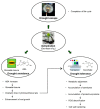Methodology of Drought Stress Research: Experimental Setup and Physiological Characterization
- PMID: 30563000
- PMCID: PMC6321153
- DOI: 10.3390/ijms19124089
Methodology of Drought Stress Research: Experimental Setup and Physiological Characterization
Abstract
Drought is one of the major stress factors affecting the growth and development of plants. In this context, drought-related losses of crop plant productivity impede sustainable agriculture all over the world. In general, plants respond to water deficits by multiple physiological and metabolic adaptations at the molecular, cellular, and organism levels. To understand the underlying mechanisms of drought tolerance, adequate stress models and arrays of reliable stress markers are required. Therefore, in this review we comprehensively address currently available models of drought stress, based on culturing plants in soil, hydroponically, or in agar culture, and critically discuss advantages and limitations of each design. We also address the methodology of drought stress characterization and discuss it in the context of real experimental approaches. Further, we highlight the trends of methodological developments in drought stress research, i.e., complementing conventional tests with quantification of phytohormones and reactive oxygen species (ROS), measuring antioxidant enzyme activities, and comprehensively profiling transcriptome, proteome, and metabolome.
Keywords: Drought stress; drought models; drought tolerance; oxidative stress; phytohormones; polyethylene glycol (PEG); stress markers.
Conflict of interest statement
The authors declare no conflicts of interest
Figures



References
-
- Wilhite D.A., editor. Drought Assessment, Management, and Planning: Theory and Case Studies. Springer; Boston, MA, USA: 1993.
-
- Shao H.B., Chu L.-Y., Jaleel C.A., Manivannan P., Panneerselvam R., Shao M.-A. Understanding water deficit stress-induced changes in the basic metabolism of higher plants—Biotechnologically and sustainably improving agriculture and the ecoenvironment in arid regions of the globe. Crit. Rev. Biotechnol. 2009;29:131–151. doi: 10.1080/07388550902869792. - DOI - PubMed
-
- Farooq M., Wahid A., Kobayashi N., Fujita D., Basra S.M.A. Plant drought stress: Effects, mechanisms and management. Agron. Sustain. Dev. 2009;29:185–212. doi: 10.1051/agro:2008021. - DOI
Publication types
MeSH terms
Substances
Grants and funding
LinkOut - more resources
Full Text Sources

